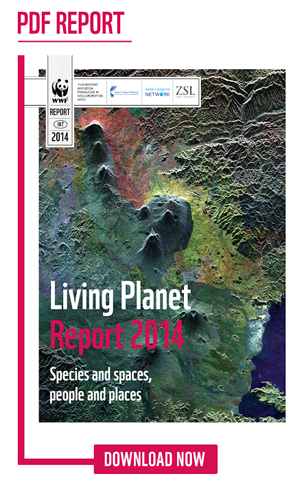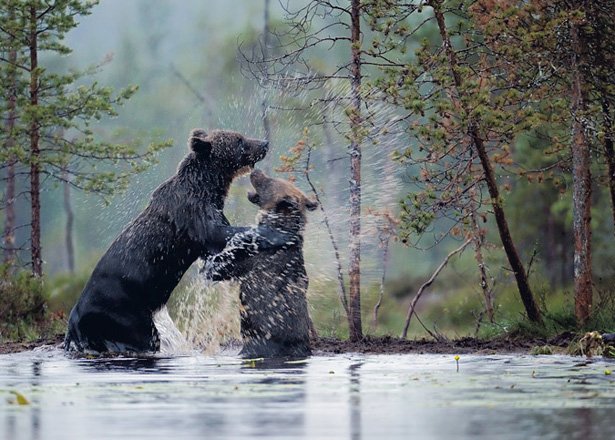In its new Living Planet Report, the Zoological Society of London (ZSL) says the global loss of species is even worse than previously thought.
The new report suggests populations have halved in 40 years, as new methodology gives more alarming results than in a report two years ago.
The report says populations of mammals, birds, reptiles, amphibians and fish have declined by an average of 52%.
Populations of freshwater species have suffered an even worse fall of 76%.
Compiling a global average of species decline involves tricky statistics, often comparing disparate data sets – and some critics say the exercise is not statistically valid.
The ZSL team says they have improved their methodology since their last report two years ago – but the results are even more alarming.

The 2014 Living Planet Report suggests wildlife populations have halved in 40 years
Then they estimated that wildlife was down “only” around 30%. Whatever the numbers, it seems clear that wildlife is continuing to be driven out by human activity.
The society’s report, in conjunction with the pressure group WWF, says humans are cutting down trees more quickly than they can re-grow, harvesting more fish than the oceans can re-stock, pumping water from rivers and aquifers faster than rainfall can replenish them, and emitting more carbon than oceans and forests can absorb.
It catalogues areas of severe impact – in Ghana, the lion population in one reserve is down 90% in 40 years.
In West Africa, forest felling has restricted forest elephants to 6-7% of their historic range.
Globally, habitat loss and hunting have reduced tigers from 100,000 a century ago to just 3,000.
In the UK, the government promised to halt wildlife decline – but bird numbers continue to fall.
The index tracks more than 10,000 vertebrate species populations from 1970 to 2010. It reveals a continued decline in these populations. The global trend is not slowing down.
The report shows that the biggest recorded threat to biodiversity comes from the combined impacts of habitat loss and degradation, driven by what WWF calls unsustainable human consumption.
The report notes that the impacts of climate change are becoming of increasing concern – although the effect of climate change on species until now is disputed.
WWF is keen to avoid despair. It points to conservation efforts to save species like:
- A Gorilla Conservation Program in Rwanda, promoting gorilla tourism
- A scheme to incentivize small-scale farmers to move away from slash and burn agriculture in Acre, Brazil
- A project to cut the amount of water withdrawn from the wildlife-rich River Itchen in the UK.
Previously, the Living Planet Index was calculated using the average decline in all of the species populations measured. The new weighted methodology analyses the data to provide what ZSL says is a much more accurate calculation of the collective status of populations in all species and regions.
A new European report suggests that some of the continent’s key animals have made a comeback over the past 50 years.
Conservationists say species such as bears, wolves, lynx, eagles and vultures have increased in numbers.
They believe that protection, curbs on hunting and people moving away from rural areas and into cities have helped Europe’s wildlife to recover.
The analysis was carried out by the Zoological Society of London, Birdlife and the European Bird Census Council.
The report was commissioned by the conservation group Rewilding Europe.
Frans Schepers, the organization’s director, said: “People have this general picture of Europe that we’ve lost all our nature and our wildlife.
“And I think what the rest of the world can learn from this is that conservation actually works. If we have the resources, a proper strategy, if we use our efforts, it actually works.”
Over the past few centuries, animals in Europe have not fared well. Hunting, habitat loss, and pollution have sent animals into decline.
But this report marks a reversal in fortunes.
The researchers looked at 18 mammals and 19 bird species found across Europe.
They found that all, apart from the Iberian lynx, had increased in abundance from the 1960s.
The largest increases were for the European bison, the Eurasian beaver, the white-headed duck, some populations of the pink-footed goose and the barnacle goose. These had all increased by more than 3,000% during the past five decades.

Europe’s key animals have made a comeback over the past 50 years
For top predators such as the brown bear, numbers have doubled. And for the grey wolf, which saw serious losses in the past, populations have climbed by 30%.
For mammals, the comeback was largest in the south and west of Europe, and their range had increased on average by about 30%. The average range of the birds remained stable.
Frans Schepers said: “The wildlife comeback actually started after World War II in the 1950s and 1960s. Compared to the numbers in the 1600s and 1700s, it’s still at a very low level, but it’s coming back.”
The researchers believe a combination of factors have been driving this return.
Legal protection in the EU, such as the birds directive and habitats directive, had helped to revive the fortunes of species, as had dedicated conservation schemes, said Frans Schepers.
And while some animals are still hunted in parts of Europe, there are often limits on the number that can be killed.
“It is also because people are leaving the countryside, which leaves more space for wildlife,” he said.
The recovery of some species, particularly large predators, has raised concerns. In France, for example, where wolves have recently returned, farmers are concerned that their livestock is at risk.
The report warns that this could be a growing problem, but suggests that governments should put in place compensation schemes to offset any losses for farmers. It also says that rural communities could benefit from more animals, as ecotourism could offer a boost to local economies.
The finding is surprising when seen in the global context, where biodiversity is in continuing decline.
Prof. Jonathan Baillie, director of conservation at the Zoological Society of London, said: “We’re trying to find success stories so we can learn from them, so we can see what works and scale that up across the conservation movement globally.
“And it is really important that we focus on success and where we are winning.
“But there are massive challenges out there globally. And we have to realize that the threats that Europe creates are not just within our borders, it’s internationally, and that we are having an impact on the 60% decline we’re seeing in low income countries around the world.”
He also warned that Europe’s wildlife was at a pivotal moment.
“We just have to be aware that into the future there will be increasing pressure for food production and so on within Europe,” Prof. Jonathan Baillie said.
“And for a lot of these species, where we have seen the gains, we might lose them again if we are not careful. So it’s our job to keep our eye on the ball.”
[youtube T8twQIh6qfA]


